Every Corner Tells a Story: The Old Town...
Without noise or concrete, the Old...
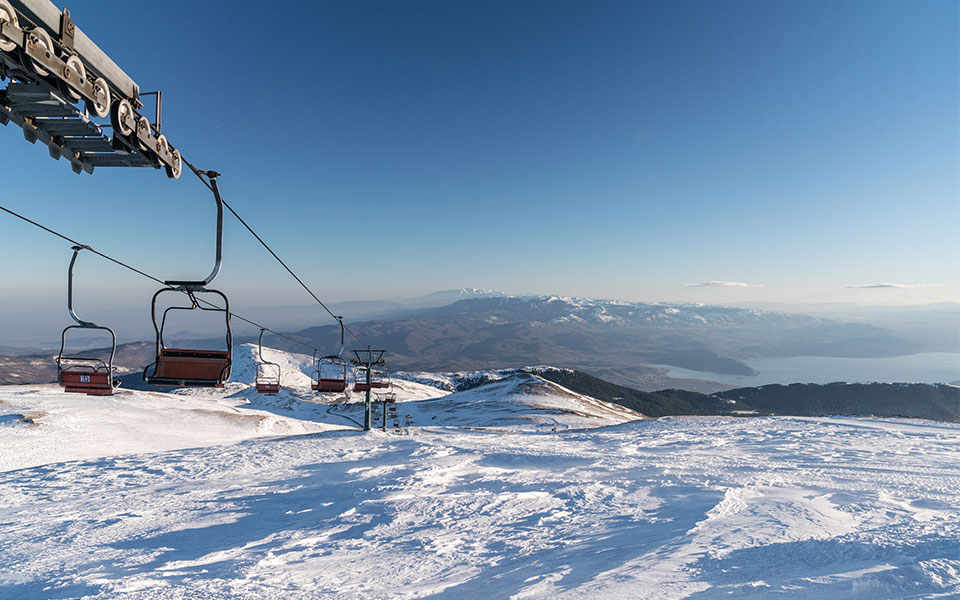
© Nicholas Mastoras
Fresh snow, blue skies with wispy white clouds and a glimpse of Lake Vegoritida are what we find on our visit to the Voras Ski Center. It’s unusual; not many ski resorts offer the sight of skiers gliding down the slopes against the backdrop of a large lake bathed in sunshine.
Mt Voras (or Kaimaktsalan, as it’s also known) is the third highest mountain of Greece, after Mt Olympus and Mt Smolikas, and its ski resort is the highest in the country (located at 2000 – 2524 m). It’s one of the most fascinating Greek mountains, with notable natural features and sites of historical importance.
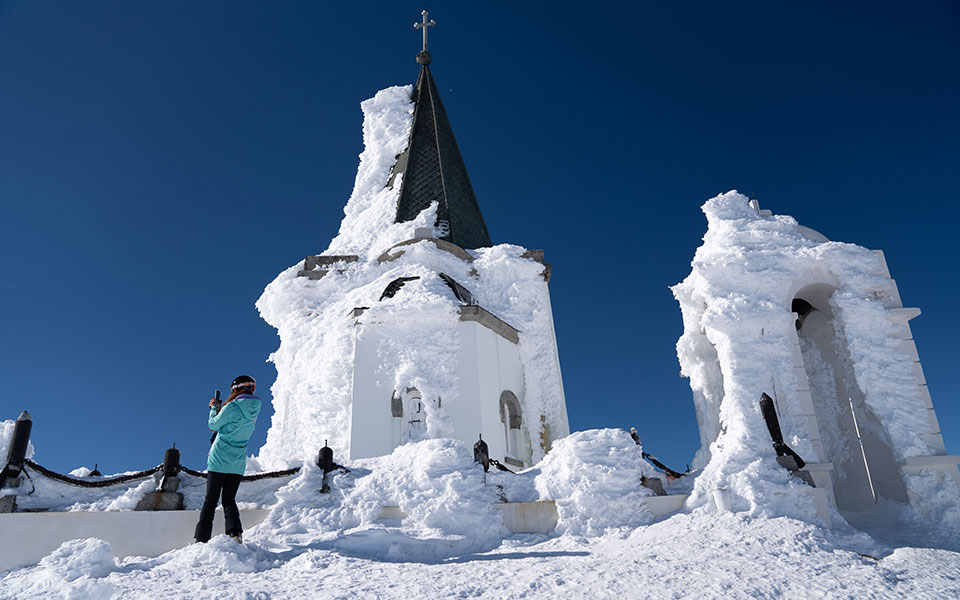
Profitis Ilias Peak, with the Church of Apostolos Petros.
© Nicholas Mastoras
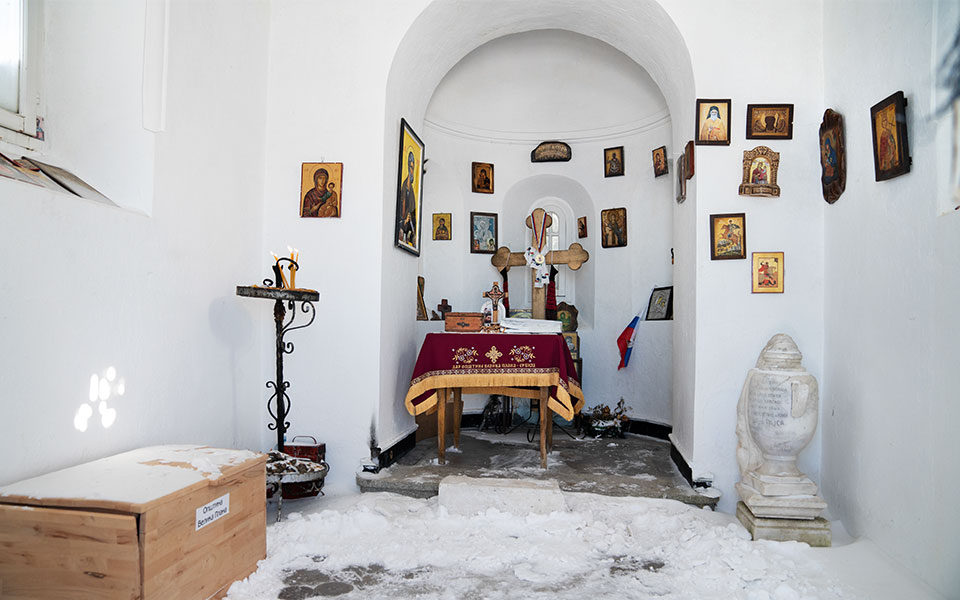
Snow blankets the small chapel on the Greece-North Macedonia border.
© Nicholas Mastoras
The most impressive place on the mountain might be Profitis Ilias Peak, with the Church of Apostolos Petros. This one spot combines European history, Balkan geography, and even a bit of Greek industrial lore. The panoramic view combines mountains (Mt Olympus, Mt Vermio, and Mt Siniatsiko), lakes (Lake Vegoritida, Lake Petron and Zazari Lake faint in the background), the Kozani mines, and areas in North Macedonia as well, as Profitis Ilias stands on the border of the two countries. The church itself is a historic monument memorializing the clash between Serbian and Bulgarian forces in September 1916 during the Battle of Kaimaktsalan in World War I. During this conflict, Profitis Ilias Peak changed hands many times until it was finally won by the Serbs, at a great cost in human lives. One hundred and six years later, skiers can pay tribute to the victory of the Allied forces at this green-roofed chapel in a snow-blanketed setting. This is yet another reason why Voras Ski Center is special; it’s for those who love history as well as for those who love skiing.
From Profitis Ilias, we catch a ride to the base of the ski resort in the ratrack, the machine that grooms the snow. Being inside a snow groomer is a rare experience, and we feel like soldiers on a mountain mission. The ratrack climbs over slopes, smoothes out the snow and leaves behind sculpted ridges , called “corduroy.”
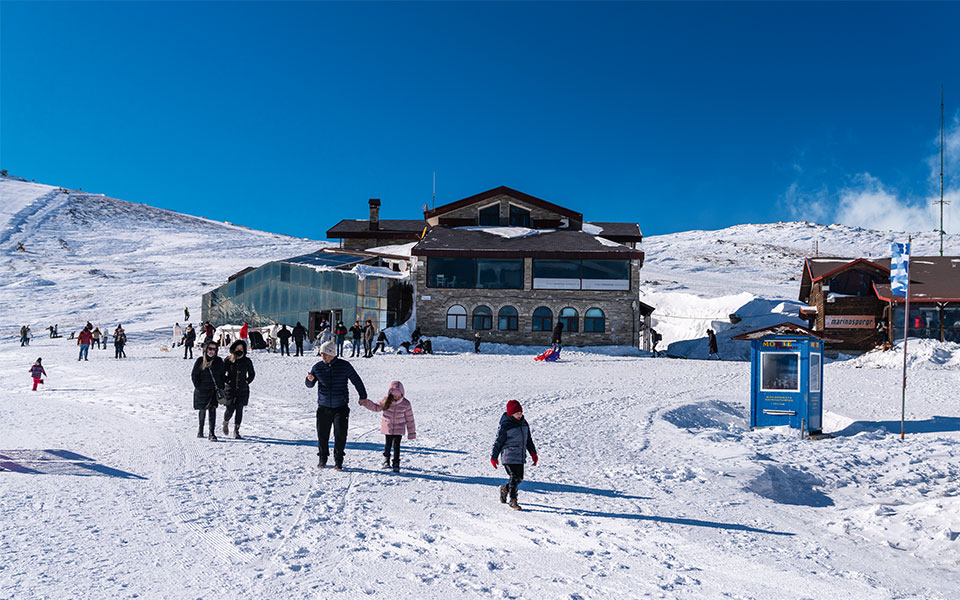
The base's Chalet 2,050 is open daily to skiers and visitors alike.
© Nicholas Mastoras
We reach the base where the main chalet, the ski school and the equipment rental shop are located. The temperature is near 0◦C but, due to the wind (25-30 kph), it feels like it’s -8◦C. Nonetheless, it’s nice dry cold weather that doesn’t bother us like when it’s humid. In fact, if we’re standing somewhere that’s sheltered by the wind, it feels quite refreshing.
It is busy; some are skiing and others are sledding. The aerial lift comes and goes, even when no one’s in it, like a flying train that runs the route whether the passengers board or not.
The Mt Voras ski resort is located in the north of the Pella region and has been operating for 27 years. In a way, it’s for northern Greece what Mt Parnassos Ski Center is for Attica, with the only difference being that it shares the pie with many more ski resorts in the area (including Vasilitsa, Seli, 3-5 Pigadia, Pisoderi, and Elatochori). It has 11 slopes (blues, reds and a racing trail for club training and competitions), up to 11km of skiing, 3 t-bar lifts, one aerial lift with two-person double chairs and two baby tow lifts for beginner skiers. Unlike most other ski resorts, it has an artificial snow system using water from Mt Voras, which – when the snow melts – returns to the mountain’s ecosystem. One of its chalets (Chalet 2,075) is open only on weekends, while the other at the base (Chalet 2,050) is open daily. It isn’t very big, but it is warm and has a large window overlooking the white landscape.
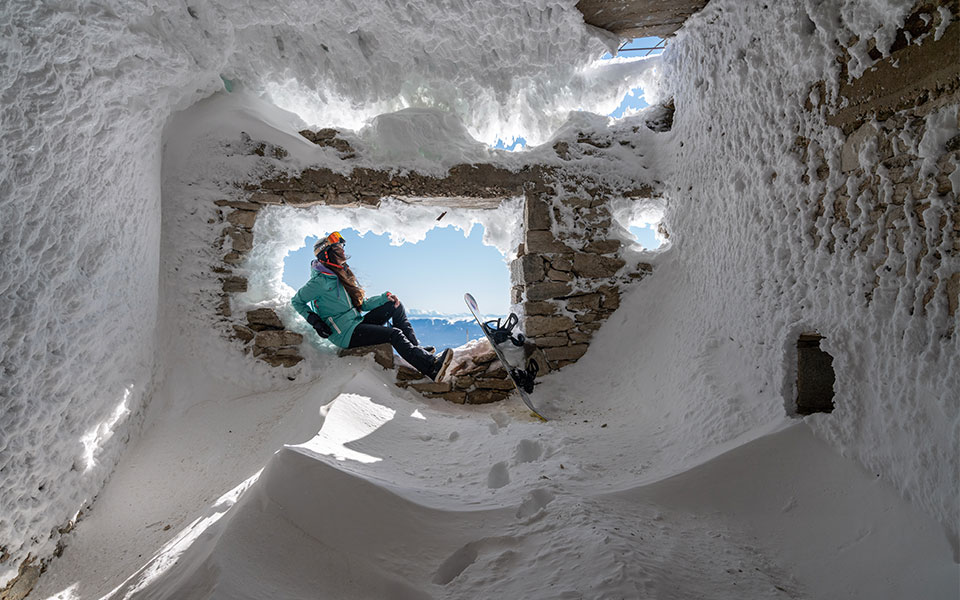
© Nicholas Mastoras
Mount Voras attracts all kinds of snow lovers: skiers, snowboarders and fans of snow kites (the latter must bring their own equipment, and it is forbidden to take off or land on the ski slopes), Northern Greeks, Southern Greeks, many islanders, tourists from Thessaloniki and even skiers from North Macedonia. On an ideal day, the resort accommodates as many as 4,500 people, skiers and other visitors alike.
Visitors range in age and alongside groups of young people you’ll see families who have come to learn the secrets of the snow together. I spy some young children following their parents like cygnets behind swans. It is obvious that they find it difficult to walk in the snow while holding their ski gear, but instead of helping them, their parents stop and wait patiently, teaching them to take responsibility for themselves when they are on the mountain.
The Voras-Kaimaktsalan Ski Center (Tel. (+30) 23810.320.00, 6943.031.001) is open from early December to mid-April, Mon-Fri 9:00-15:00 (€15) and weekends 9:00-16:00 (€20). On its website, you can find a price list with the discounts available to different categories of skiers.
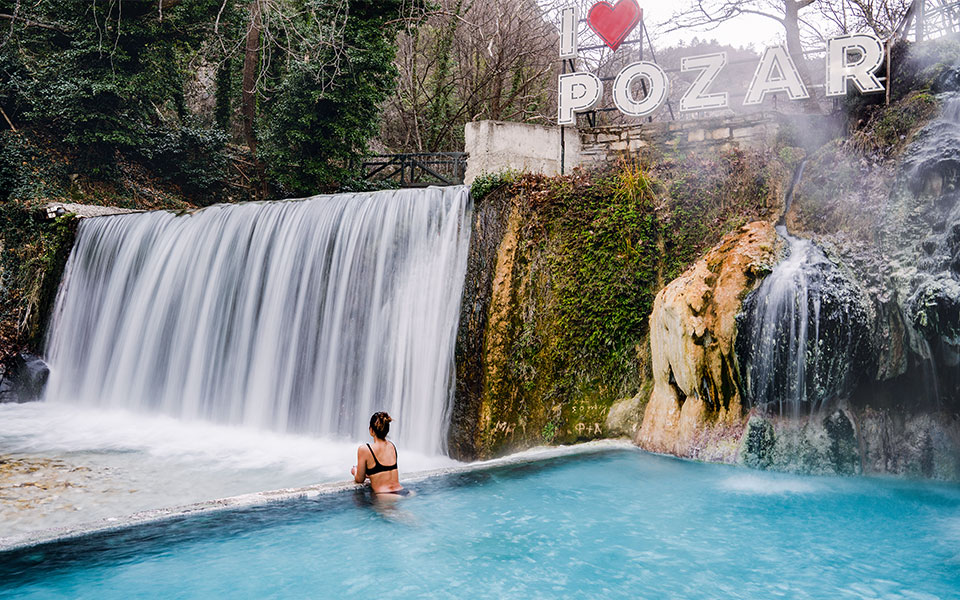
From the small waterfall on the right comes hot water from a thermal spring, while the big waterfall on the left is full of cold mountain water.
© Nicholas Mastoras
A visit to the Voras Ski Center is a wonderful experience, worth it not just for the activities but for the history, the location, and the views as well. It’s not, however, the only attraction in the area. From the icy mountain, we head down to warmer temperatures. In fact, we’ll be going from 0◦C to 37◦C and from snow to steam, combining experiences that most travel guides don’t cover. This is one of the great things about Pella; in an hour and a half, you can go from the slopes of Mt Voras to the hot springs of the Pozar Thermal Baths.
Instead of a long trip through the more remote villages on secondary roads, we take the Florina-Edessa National Road to reach Pozar, riding past leaf-strewn fields, vast tracts with bare fruit trees, including cherry trees that will, in a few months, spring into full bloom. The villages, too, look inhabited but asleep, with not a resident in sight, as if everyone were dozing in front of their fireplaces or wood stoves.
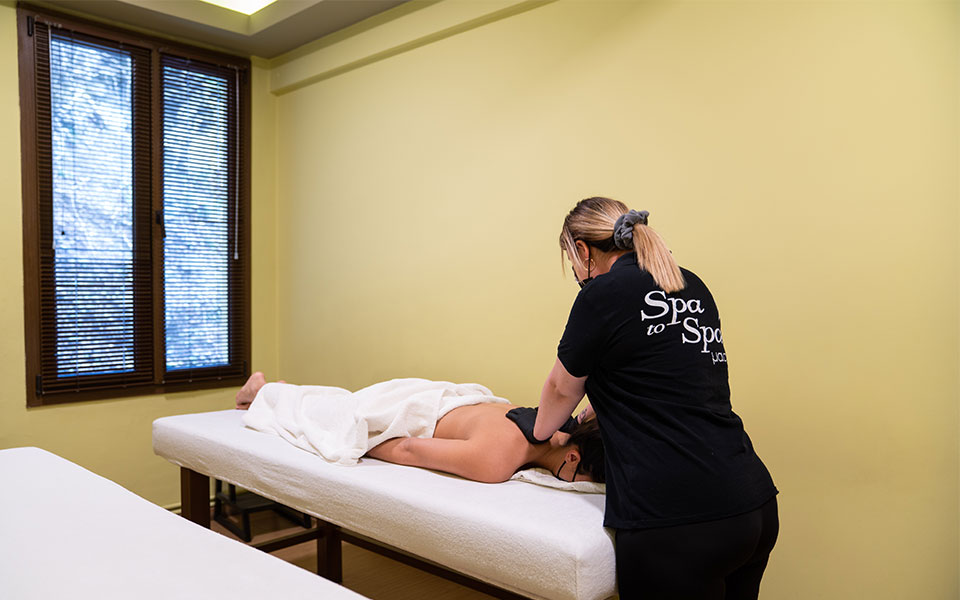
Spa to Spa
© Nicholas Mastoras
The Pozar Thermal Baths are located between Orma and Loutraki, the main tourist hotspots in the area, filled with hotels and restaurants. The baths liein the valley of the Thermopotamos (or Nikolaos) river, where there are springs of warm water, full of beneficial minerals. The (Slavic) word Pozar is translated as “under the fire”. In the river, there are pools and waterfalls where the water reaches a temperature of 37◦ Celsius. Minerals in the water include potassium (helps the cardiovascular and digestive system to function), sodium (to maintain the balance of body fluids), and fluoride (helps treat osteoporosis).
Spa therapy here is very popular, and the reputation of the baths transcends the country’s borders. Before the pandemic, tourists from North Macedonia were regular visitors to the Pozar Thermal Baths. The facilities are quite large, and include both the old hydrotherapy center and the more modern “Alexandrio” center, which was renovated six years ago, as well as a large outdoor pool under the coffee shop and smaller basins which lie along the river’s course.
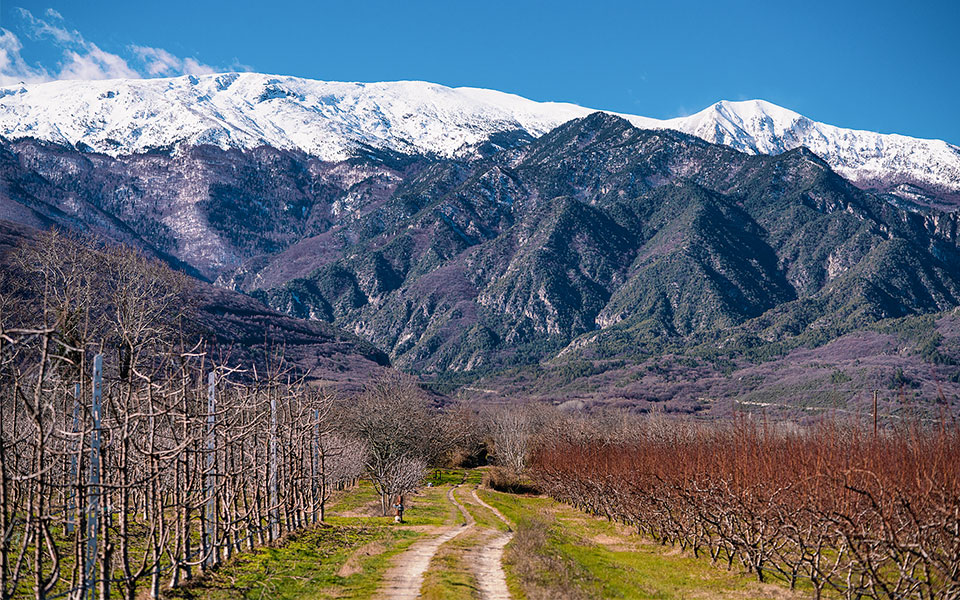
© Nicholas Mastoras
The bathers are few on the Friday morning of our visit, but more people arrive as the hours go by. The big swimming pool attracts the most people. Some swim as if they’re at a training session, while others sit shoulder to shoulder as if they’re in a hot tub. Everyone seems to be in high spirits until a light snow starts to swirl and the water ripples with the breeze. One by one, they start to leave, even though they seem excited by the change in weather. We jump into a pool with a waterfall, and when we get out, we feel stronger, as if our bodies have stored the power of the hot water and are now invulnerable to the cold. Another highlight comes a little later – a great massage at Spa to Spa. In Loutraki, there are centers like this for therapeutic or relaxing massage, hydration, aromatherapy and lithotherapy, with hot and cold stones.
After the massage, we head to a tavern in town for lunch. On the way, we pass a group of people, four middle-aged couples, one in a bathrobe and boots, another with a bathing cap and coat, the third in socks and flip flops. One lady isn’t even wearing shoes; she’s strolling down the sidewalk wrapped in a towel. They’re not crazy, or would-be trend-setters, or carnival-goers. They’re just some of the visitors to the Pozar Thermal Baths, gracing this very special corner of Macedonia with their presence.
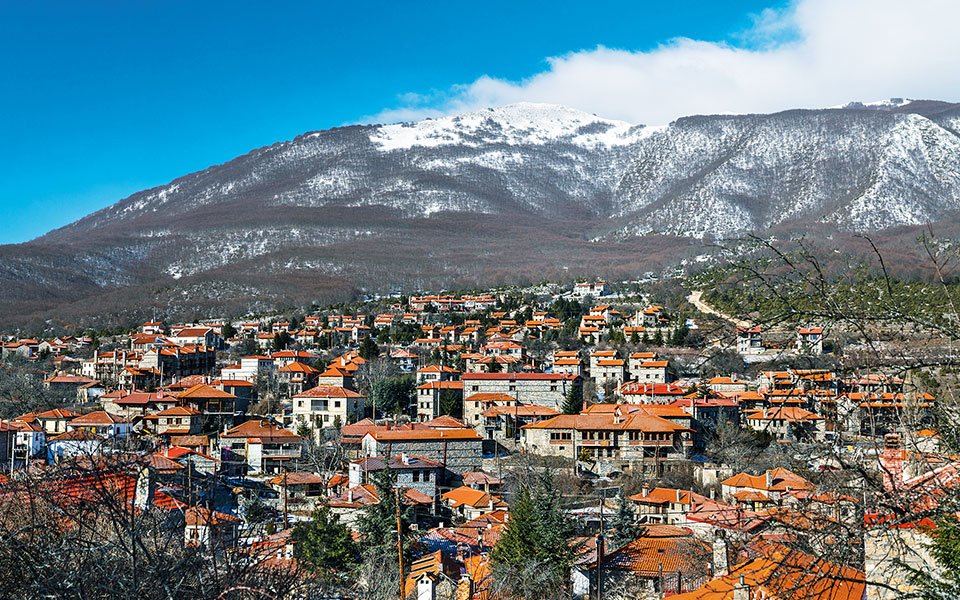
A panoramic view of Paleos Agios Athanasios, built at 1,200 meters.
© Nicholas Mastoras
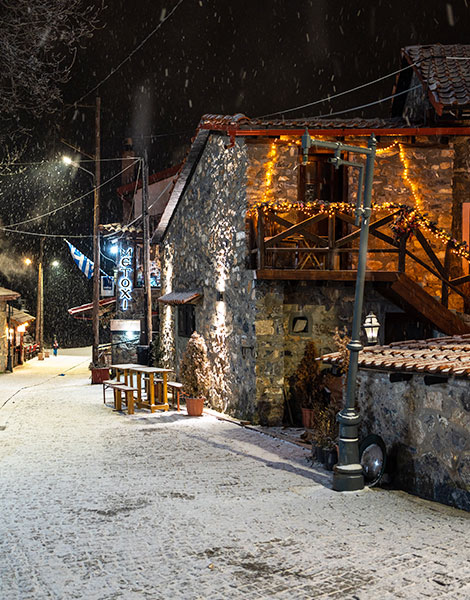
Paleos Agios Athanasios,.
© Nicholas Mastoras
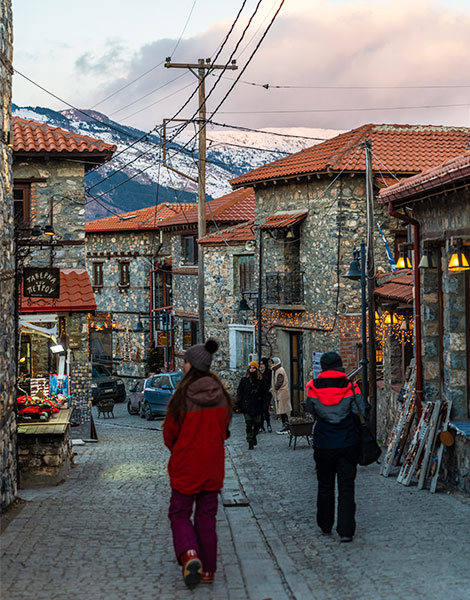
Paleos Agios Athanasios.
© Nicholas Mastoras
Paleos Agios Athanasios, just a half hour’s drive from the Voras Ski Center, is a jewel. The mountain village, located at an elevation of 1200 m, was deserted during the ’80s when its residents relocated to Neo Agios Athanasios. The new village is lower down the mountain (at 700 m) and gets less snow, which makes everyday life easier for its inhabitants. After 1995, when the ski resort began operations, Paleos Agios Athanasios began to develop as a tourist destination. Over time, it filled with hostels and tavernas serving visitors from Greece and abroad. They admired its Macedonian stone houses, snow-covered cobblestone streets and round yellow street lamps, shining their dim light out in the icy -15◦C nights.
The activities that supported the village economy before tourism have partially survived. Agricultural production still exists, and there are agro-tourism estates full of cherry, apple and peach trees. On the other hand, livestock farming has almost disappeared, with many fields around the village – where fodder was once grown – converted into plots with vacation homes. This beautiful and atmospheric village is ideal for long walks and good food. Its main tourist season is in winter; in summer, visitor traffic is significantly reduced.
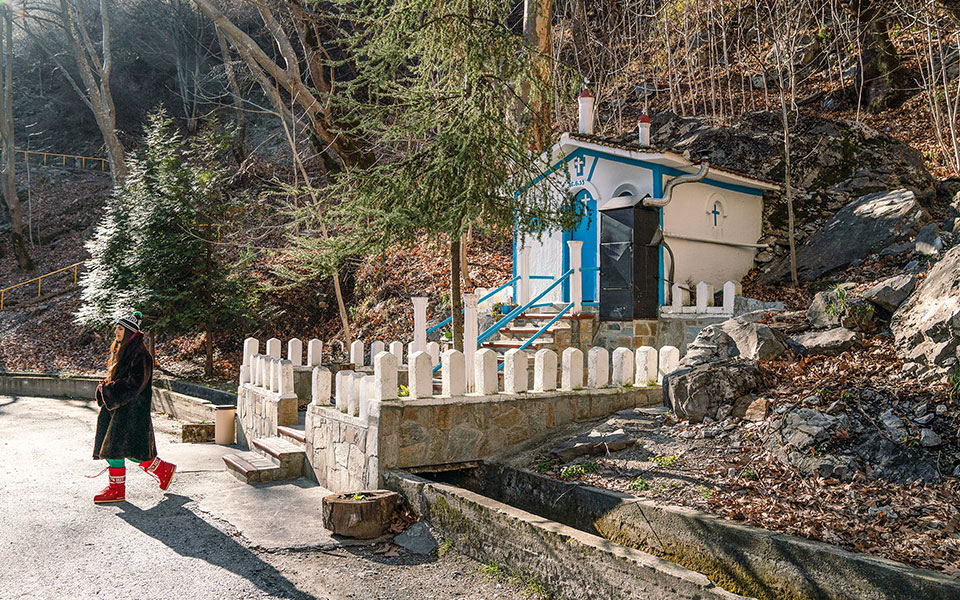
The Loutraki chapel is called "Agiasma" because of the spring located inside it.
© Nicholas Mastoras
In Loutraki… but not for the thermal baths Loutraki is best known for its thermal waters, but it offers a variety of other activities as well. We set out from here on two different excursions, a car ride and a hiking trip. The car ride took us to Agios Nikolaos, a white and blue chapel built on a rock outcropping, which the locals call “Agiasma” (“Holy Water”), due to a spring located inside. (It should be noted that there is another chapel nearby, also called Agios Nikolaos, but that one is painted white and red). The church, surrounded by bare trees and large stones, stands at the edge of Galana Nera Gorge, which runs from here to the Kali Pediada plain.
Hiking options are even more interesting. A route of moderate difficulty in the Loutra Gorge, partially marked, starts from Ano Loutraki. If you’ve crossed gorges before, you can try it on your own, but if you’re inexperienced, it’s better to have a guide. We hike in the company of a nature connoisseur and graduate mountain guide from DIEK Aridea, Municipality of Nitsi, the local vocational school. The journey takes two hours. If you start from Ao Loutraki, you ‘ll be heading downhill, so the return trip will be a bit more strenuous. We head for the Agios Nikolaos stream, passing through stands of cherry trees, plane trees and cedars, and gazing up at the Sokol of Voras Peak before making a small descent with a rope to reach the trail’s end at the 12m-high burbling waterfall of Kounoupitsa.
Information about hiking the Loutra Gorge can be obtained from the Municipality of Nitsi, Tel. (+30) 6970.951.339.
TRAVEL
Paleos Agios Athanasios is 575 km (6.5 hours) from Athens and 125 km (2 hours) from Thessaloniki. Estimate costs for gas and tolls at €85 and €15 respectively.
ACCOMMODATION
In the hotel Pozar Pallas (Loutraki, Tel. (+30) 23840.913.57, from €80 per double room, with breakfast) you’ll find a variety of rooms (double room, suite for three, two-bedroom apartment for four, two-bedroom apartment for six). Warmly decorated and offering a hearty breakfast (including eggs, savory pies, croissants, local jams, and honey), the hotel is ideal for fans of thermal tourism and exercise. It has a Turkish bath, Jacuzzi, sauna, massage and body and face treatments as well as a gym. Perhaps its most impressive feature is the salt cave, an area designed especially to promote wellness and relaxation (spatherapy.gr).
Voras Guesthouse (Paleos Agios Athanasios, Tel. (+30) 23810.314.93, from €60 per double room, without breakfast) has double rooms (with or without fireplace), family rooms and suites (deluxe option includes fireplace and a hot tub).
The Chalet Sapin (Paleos Agios Athanasios, Tel. (+30) 23810.315.48, from €130 euros per double room, including breakfast) has 16 rooms, six of which have balconies that overlook the village and the mountain peaks of Voras. Breakfast includes eggs, cured meats, cheeses, cakes, bougatsa and fruit.
FOOD – COFFEE
The ski center’s chalets offer drinks and refreshments, snacks, hot dogs, pizzas, sandwiches and drinks. In Paleos Agios Athanasios you’ll find many restaurants.
The taverna Kalyva (Tel. (+30) 6980.562.222) is the place for meat soup, steak pancetta, beef liver, T-Bone steak, greens and Florina peppers. They also have a selection of wines, including a dry red, a Kaliva white Chardonnay; a semi-sweet Merlot; and their own house wine.
At Kala tis Antonias (Tel. (+30) 6932.419.735) try the fava, the beef kavourma, the noodles with meatballs and barliva, and the Bachovo peppers stuffed with cheese, fresh tomatoes and egg.
For hot chocolate, coffee and liqueurs, visit the Xionodromos Café (Tel. (+30) 6938.573.879), and for cocktails and whiskey, stop in at the Grand House (Tel. (+30) 23810.398.19). In the tourist shops of the village, you’ll can find various gastronomic souvenirs with names that honor sites in the area (including “Palios Agios Athanasios” tea, “O Voras” oatmeal, and “Kaimaktsalan” mustard and mayonnaise).
At the Pozar Thermal Baths, there are a few small shops, including the Tserkezos cheesery (Tel. (+30) 6983.013.261), carrying all kinds of traditional products.
In Loutraki, the top dining choice is Hydrolithos (Tel. (+30) 23840.916.00), a restaurant offering creative Greek cuisine, which serves – among other things – winter dakos with carob rusks, grilled beets, feta mousse and orange jelly; mushroom ragout; and kontosouvli pork with lemon sauce.
In the restaurant Paradosiako (Tel. (+30) 23840.910.17), you can find delicious dishes, including many kinds of salads, soups, stews and grilled meat.
On the way to Orma, you’ll find the restaurant Kokkino Piperi (Tel. (+30) 23840.911.00; it offers a variety of cheeses, such as PDO batzos, vegetables, meat dishes and a long wine list. You can even buy products such as the Macedonian tsipouro of the Melissanidis family and the trachanas of Almopia.
Dionysos restaurant in Orma has a very good reputation (Tel. (+30) 23840.944.10), too. Here, Karadzovitiki tigania is made with Greek sausage and Dorothea leeks, and you can get homemade burgers and savory pies filled with gruyere cream.
TIPS
A trip like this can be made easier with a little planning. If you can rent a 4×4 car, you may be more comfortable on the road to the ski resort. In any case, whatever car you choose, you must have snow chains or snow covers and know how to put them on properly because the weather is unpredictable. Before going up to the ski resort, check its Facebook page to make sure it’s not closed due to sudden inclement weather.
Profitis Ilias and Apostolos Petros Church can be reached on foot and are a 20-minute walk away from the Sarantovrisi 1 lift.
As you get friendlier with the crowd here, you’ll notice that, when someone wants to treat you, they’re to offer you Jägermeister rather than the local tsipouro.
Without noise or concrete, the Old...
A visit to the thermal waters...
Unexpected discoveries and timeless classics. Everything...
A challenging summer ride across the...